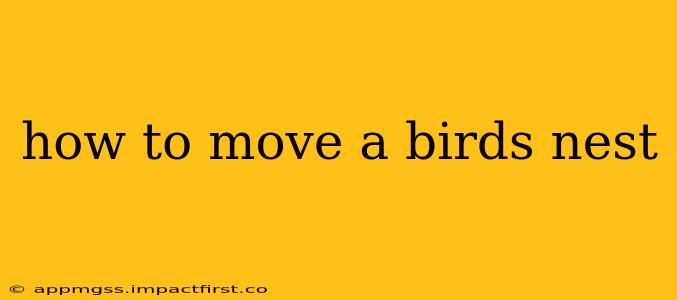Finding a bird's nest on your property can be a surprising and potentially concerning discovery. While it's natural to want to protect both the birds and your property, moving a nest requires careful consideration and should only be done under specific circumstances and with the proper approach. This guide will walk you through the ethical and practical aspects of relocating a bird's nest, ensuring the safety of the birds and compliance with relevant laws.
When is it Necessary to Move a Bird's Nest?
Before considering moving a bird's nest, it's crucial to understand that most of the time, intervention is unnecessary. Birds are remarkably resilient and capable of raising their young even in close proximity to humans. However, there are limited situations where relocation might be considered:
- Immediate Danger: If the nest is in a location that poses an immediate threat to the birds, such as within a frequently used area, near heavy machinery, or subject to severe weather exposure, relocation may be necessary.
- Construction or Renovation: If construction or renovation work is unavoidable and will directly impact the nest, relocation may be the only option.
- Pest Infestation: In rare cases, if the nest is heavily infested with parasites, relocation might be considered in consultation with a wildlife rehabilitator.
Important Note: In many regions, it's illegal to disturb or remove a bird's nest without proper permits. Always check with your local wildlife authorities or environmental agencies before taking any action.
How to Safely and Ethically Relocate a Bird's Nest
If, after careful consideration and consultation with the relevant authorities, you determine that relocation is absolutely necessary, follow these steps:
1. Timing is Everything:
Relocation should only be attempted when the chicks are very young and still heavily dependent on their parents. Older chicks are less likely to survive relocation. Ideally, the intervention should happen before the eggs hatch or when the chicks are very young and unable to leave the nest on their own.
2. Choose the Right Location:
The new nest location should mimic the original as closely as possible. Select a location that is:
- Safe and sheltered: Away from predators, extreme weather, and human activity.
- Similar in height and structure: The new nesting site should provide a similar level of protection and support.
- Close to a food source: Ensure the area has sufficient food and water for the parents to feed their young easily.
3. The Relocation Process:
- Contact a Wildlife Rehabilitator: This is the most important step! They have the expertise to handle the delicate process safely and legally, and may even be able to handle the relocation for you.
- Gentle Transfer: If you're performing the relocation yourself, carefully transfer the nest and its contents (eggs or chicks) into a new nest or a suitable replacement container (like a shallow basket lined with soft material).
- Placement: Place the relocated nest in the pre-selected location and make sure it's secure.
- Monitoring (if possible): Without disturbing them, it's a good idea to discreetly observe to make sure the parents are able to find the nest and continue caring for their young.
What if the chicks have fallen out of the nest?
This is a scenario where immediate help is crucial. Do not attempt to put the chick back in the nest yourself. Instead, contact your local wildlife rescue or rehabilitation center immediately. They have the expertise to handle this delicate situation appropriately.
What NOT to Do When Dealing with a Bird's Nest:
- Don't touch the eggs or chicks unnecessarily. Your scent may cause the parents to abandon the nest.
- Don't attempt to clean or repair a damaged nest.
- Don't relocate the nest if it's not absolutely necessary.
- Don't handle the birds directly unless you are a trained wildlife rehabilitator.
By following these guidelines and seeking professional assistance when needed, you can help ensure the well-being of the birds and maintain compliance with wildlife laws. Remember, responsible stewardship of wildlife often means letting nature take its course.
